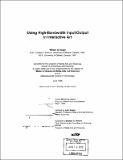Using high-bandwidth input/output in interactive art
Author(s)
Keays, William G. (William George), 1960-
DownloadFull printable version (17.16Mb)
Alternative title
Using high-bandwidth I/O in interactive art
Other Contributors
Massachusetts Institute of Technology. Dept. of Architecture. Program In Media Arts and Sciences.
Advisor
John Maeda.
Terms of use
Metadata
Show full item recordAbstract
Are we making the best use of commonly available high-bandwidth input/output ( I/O) devices on our computers? How would research on this subject be affected if it were driven by a purely artistic mandate? The bandwidth in question refers specifically to video input and output devices, the only high-bandwidth devices that are on found on common, conventional computers. Under normal circumstances, these devices transmit moving two dimensional images at rapid refresh rates; this high-bandwidth is a prerequisite for the capturing and viewing of motion images. A great potential exists in using this high-throughput capacity in applications that do not simply convey continuous moving images. In the burgeoning field of highly technological interactive art, a large number of works suffer from poorly adapted interface mechanisms. New high-bandwidth I/O configurations can serve to derive improved interfaces for the creation of interactive art. This course of research is not driven solely by the desire to create new technology and improved modes of interaction. As the the infusion of rapid-changing technology in art reaches popular levels, the role of the artist in society is equally in flux. The definition of such a role is sought as part of this thesis. These goals are accomplished through the study of the nature and history of interactivity in art, the development of new prototypes, the creation and exhibition of interactive art works in public spaces, and through a close analysis of the role of the artist-scientist in contemporary society.
Description
Thesis (S.M.)--Massachusetts Institute of Technology, Program in Media Arts & Sciences, 1999. Includes bibliographical references (leaves 75-78).
Date issued
1999Department
Program in Media Arts and Sciences (Massachusetts Institute of Technology)Publisher
Massachusetts Institute of Technology
Keywords
Architecture. Program In Media Arts and Sciences.